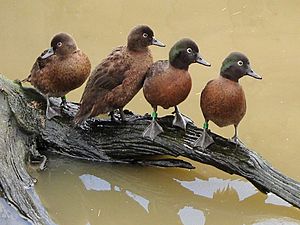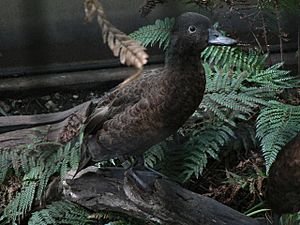Campbell teal facts for kids
Quick facts for kids Campbell teal |
|
|---|---|
 |
|
| Conservation status | |
| Scientific classification | |
| Genus: |
Anas
|
| Species: |
nesiotis
|
| Synonyms | |
|
Anas aucklandica nesiotis |
|
The Campbell teal (Anas nesiotis) is a small duck that cannot fly. It is active at night, which means it is nocturnal. This special duck lives only on the Campbell Island group in New Zealand.
The Campbell teal looks a lot like the Auckland teal. It has dark brown feathers. Males have a shiny green head and back, and a reddish-brown chest. Females are dark brown all over. These ducks live in grassy areas with ferns. They also use burrows made by other birds. They seem to protect their own space. They probably eat small water creatures and insects. The IUCN says the Campbell teal is a vulnerable animal. This means it needs help to survive.
Saving the Campbell Teal
The Campbell teal used to live on Campbell Island. But it disappeared from there because of rats. Norway Rats were brought to the island. These rats ate the teal's eggs and chicks. For a while, people thought the Campbell teal was completely gone.
Rediscovery and Rescue
In 1975, a small group of Campbell teals was found. They were on Dent Island. This tiny island is near Campbell Island and had no rats. The population was very small. Just one bad event could have wiped them out.
To save them, 11 ducks were taken to a special center. This was the Pukaha / Mount Bruce National Wildlife Centre. Here, experts tried to help them breed. More ducks were brought in later. In 1979, the Campbell teal was listed as critically endangered.
Breeding Success
At first, breeding the ducks in captivity was hard. No one knew much about their behavior in the wild. The staff at Mount Bruce had to try many different ways to get them to breed.
Finally, in 1994, they had success! A female duck named Daisy laid eggs. She was the only wild female to ever lay eggs in captivity. After that, the ducks bred every year. This helped to increase their numbers.
Returning Home
In 1999 and 2000, 25 captive-bred ducks were moved. They went to Codfish Island. This island was already free of pests. It was a safe place for other endangered birds like the kakapo.
The biggest rat removal project ever happened in 2001. Helicopters dropped poisoned bait all over Campbell Island. This removed about 200,000 Norway rats. The island was declared rat-free in 2003.
In 2004, 50 Campbell teals were brought back to Campbell Island. They had been gone for over 100 years. Some were from the breeding center. Others had lived on Codfish Island. By 2005, most of these birds were doing well. By 2011, the Campbell teal was back on Campbell Island. Because of this success, its threat level was lowered. It is now considered vulnerable again, which is much better than critically endangered.



